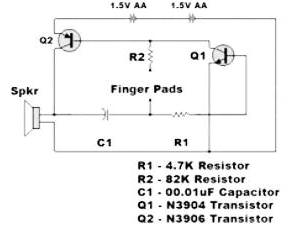How to Make a Lie Detector?
One normally assumes that lie detectors are only used on criminals. But they don’t have to be used only in that capacity. You can build a lie detector just for fun – using some basic electronics tools and knowledge. It’s fun to use with friends and… maybe to check whether your student’s dog really ate his homework.
Things you need
One 4.7k resistor, One 82k resistor, One 0.01uF capacitor, One 2N3904 transistor, 2-AA battery holder, Project enclosure, Circuit board/breadboard, PC speaker, Velcro tape, Aluminium foil, Wire, Two AA batteries, Soldering iron, Solder, Screws, Screw driver, Drill, Glue
All parts can be easily obtained from local electronics stores. Engineering students should have no difficulty obtaining the parts, some of which can easily be found in the house. If you are using a breadboard, you don’t need item number 7, and those from 14 to 19. Those are only needed if you are using a circuit board and want to solder parts to it. Soldering obviously ensures a more permanent connection that is less likely to loosen up and cause the circuit to not work. However, you can simplify the process and use a breadboard, keeping in mind that the lie-detector will be a temporary project and would break apart if the breadboard is turned upside down.
Steps of construction
1# Construct the circuit on the breadboard (or via soldering)
2# Construct the finger pads: first, take a rectangular piece of Velcro tape and cut out aluminium foil according to the size of the Velcro tape. Peel off the sticky side of Velcro tape and place the piece of aluminium foil on it. Don’t forget to slide in the wire lead of finger pads. Once you have fixed the wire and aluminium foil on the sticky end of the Velcro tape, roll it around and fasten it with another piece of Velcro tape. Repeat this step to construct two finger pads.
3# If you are using a breadboard, then your project is ready to be tested out. Or for a more sophisticated look, attach your circuit board to the project enclosure with screws and drill out holes in the box for the finger pads. You may also drill holes where the speaker is in order to hear the sound better.
The technology behind it
The simple lie detector works on a principle called ‘galvanic skin response (GSR)’. It measures the conductance (inverse of resistance) of the human skin. When you lie about something, you tend to sweat (either profusely or hardly-noticeable), so the skin becomes moist. As soon as the skin moisture increases, the conductance also increases (resistance decreases). This change in conductance affects the frequency of the speaker’s tone. High conductance leads to a high frequency tone, thus producing a higher sound from the speakers, indicating that the ‘subject’ is lying.
Author Bio:– Sohail Qaisar is a professional writer, and he writes informative articles for his blog technology review, checkout his views on megagate’s 1st touch-screen and most valuable phone in the market, megagate titan t610 review.



